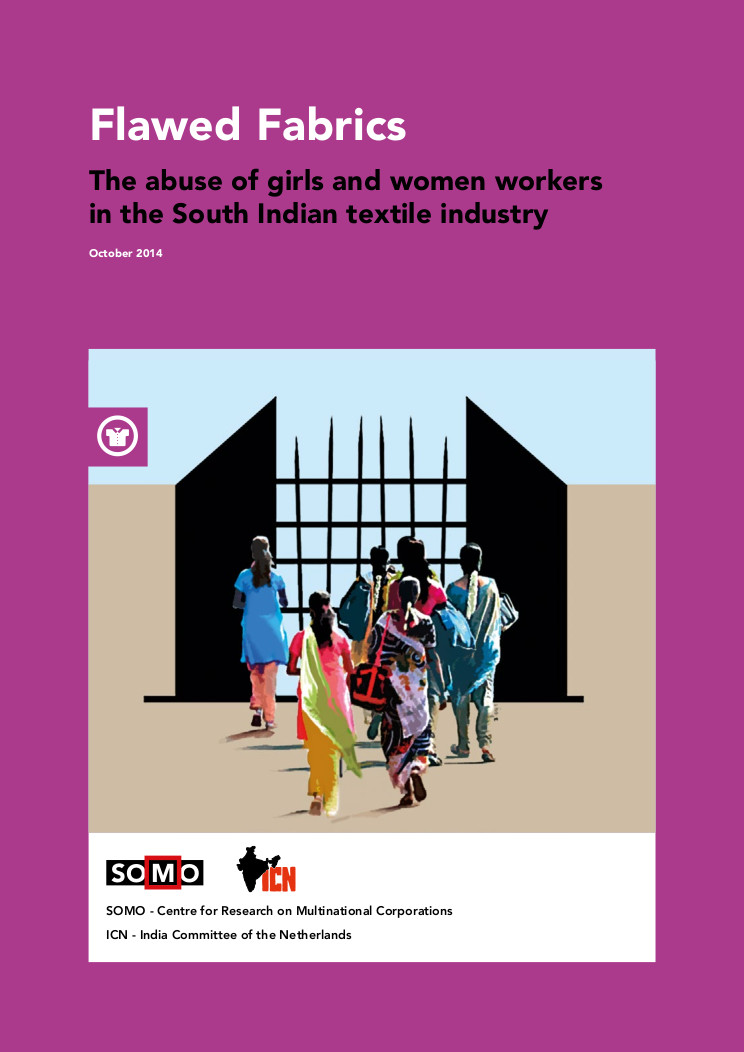
Flawed Fabrics report has international impact
A report titled ‘Flawed Fabrics’ was published recently. Jointly authored by the SOMO and the India Committee of the Netherlands (LIW), it describes how the South Indian girls and young women who make the yarn and fabrics for our clothes are being subjected to exploitation and forced labour. Following its publication, companies and politicians responded to its findings, which were also discussed in many news outlets —from international newspapers and magazines through blogs, to radio and television broadcasts.
‘Flawed Fabrics‘ reveals that girls and women are being forced to work overtime in exchange for low wages, they stay in dormitories and are rarely allowed out of the factory compound. The five cases that came under scrutiny concerned factories that deliver products to western brands such as C&A, H&M and Primark, as well as to Bangladeshi clothing factories.
Structural improvements
Dutch companies are hardly making any efforts to address these abuses. Despite the action plan for sustainability in the Dutch textile and garment industry by the industry organisations Modint, Inretail and VGT, which includes tackling forced labour in South India, no structural improvements have yet been realised. It is especially alarming that a large number of the businesses mentioned in the SOMO/ICN(opens in new window) report have not even responded to the report. Out of a total 28 companies, 18 chose to stay silent, among them HanesBrands. It is therefore impossible to know whether these companies are aware of the problems in their production chains, or what they are doing to address the issues.
Transparency is necessary
The details that fashion brands and chain stores are publishing about their suppliers are few. H&M is an exception: their website lists thousands of production sites worldwide where the Swedish company is doing business. Their list, however, only points to suppliers of finished products, i.e. garment manufacturers. H&M has also mapped its further tier suppliers, like the spinning mills in India, but this information is not being released. Neither is there any clarity on H&M’s criteria for assessing spinning mills. Following the widespread attention Flawed Fabrics attracted in the media, H&M announced they were breaking their ties with Super Spinning Mills. ‘Cut and run’ may have a negative impact on workers. For workers, the situation remains unchanged or worse, if a factory loses orders, they might lose their jobs. Therefore, SOMO and ICN are of the opinion that companies should refrain from discontinuing relations with suppliers on the basis of non-compliance. Rather, buyers should use available leverage, either as an individual company or together with other companies, to ensure that conditions are improved and rights of workers are respected, in line with the United Nations Guiding Principles on Business and human rights.
H&M should dedicate more efforts to improve the situation locally. This is not only true for H&M but for all companies that purchase from Indian manufacturers. C&A(opens in new window) en Primark (Dutch only)(opens in new window) have also been mapping the spinning mills throughout their production chains, but they hardly release any details about how they are doing this, what types of situation they are encountering, and what impact their improvement initiatives are having.
Political responses
It’s not only up to companies to take action and tackle abuses, political engagement is also needed. Here are some examples of actions and responses that have emerged from the political field.
- Three members of the European parliament (of the conservative, socialdemocrat and liberal political groups) asked questions at the European Commission’s 11 November session, following the release of the report.
- On 31 October, MP Joël Voordewind (of the ChristenUnie party) delivered his questions to parliament in writing. Minister Ploumen of foreign trade and development cooperation addressed these questions on 14 November.
- The Minister also raised the issue of child labour and the situation in the Indian textile factories during her trade trip to India.
Media
The report was picked up well beyond the Dutch borders, and discussed in depth in the international media: there was a blog in the Guardian, an article in The Times UK, and a story on the website of Vogue UK. In the Netherlands, the TV news shows NOS Journaal, and the Jeugdjournaal (for young viewers), as well as the Volkskrant newspaper, were among the first to publish several items on the issue. Many TV shows, such as Hart van Nederland and RTL Nieuws, also paid attention to the report. All national newspapers featured an article about it, as did many news sites, including Dutch and international fashion blogs. Radio stories and interviews with the researchers were broadcast through FunX, NOS radio 1, Amsterdam FM, BNR and 3FM, among others.
Partners
Related content
-
Flawed fabrics Published on:
 Pauline OvereemPosted in category:Publication
Pauline OvereemPosted in category:Publication Pauline Overeem
Pauline Overeem
-
 Flawed Fabric – The abuse of girls and women workers in the South Indian textile industryPosted in category:NewsPublished on:
Flawed Fabric – The abuse of girls and women workers in the South Indian textile industryPosted in category:NewsPublished on: -

-

-
 Expert meeting towards decent work in the Indian textile and garment industry and the role of the NetherlandsPosted in category:NewsPublished on:
Expert meeting towards decent work in the Indian textile and garment industry and the role of the NetherlandsPosted in category:NewsPublished on:

